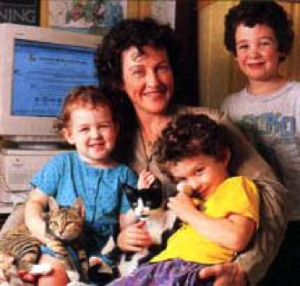 As Cheryl Clark began a weekend horseback ride one sunny October afternoon in 1997, a time bomb went off. A violent seizure threw the 48-year-old former athlete to the ground. A CAT scan revealed a brain tumor the size of a lemon.
As Cheryl Clark began a weekend horseback ride one sunny October afternoon in 1997, a time bomb went off. A violent seizure threw the 48-year-old former athlete to the ground. A CAT scan revealed a brain tumor the size of a lemon.
Surgeons quickly removed the tumor, but the pathology report delivered a devastating diagnosis: Glioblastoma Multiforme IV, the most aggressive of brain tumors. Even when removed, this tumor grows back with a vengeance. Oncologists consider it incurable and gave Clark 3-6 months. Yet more than two years later Clark not only survives, but thrives. She jogs, helps conduct brain tumor research, and is active in a brain tumor support group she helped form.
Clark’s stunning recovery is due to a holistic approach that starts with an intensive nutritional program designed by nutritionist and Ph.D., Jeanne Wallace, who prescribed reducing sugars, and emphasizing Omega-3 fats, found in fish and flax, to slow tumor growth and strengthen Clark’s immune system. Wallace also prescribed an array of herbal and natural dietary supplements.
Clark became deeply involved with her oncologist and her treatment, and after much research, opted for radiation instead of the customary chemotherapy. Wallace’s regimen of diet and herbal remedies helped maximize the radiation’s effect while protecting healthy tissue and reducing swelling. As a result, Clark had no fatigue, side effects or complications from radiation. The tumor responded well.
Clark also invested in other holistic treatments, like acupuncture, Belle Ruth Naparstek’s visualizations for cancer, affirmations, prayer, massage (zero balancing, polarity, Shiatsu), and cultivating a positive attitude.
“I haven’t always had a positive attitude.” Clark lost both parents to cancer–her father in 1982, her mother in 1985. An important relationship ended in 1989. “My attitude bottomed-out, and I felt like giving up on life. For years I didn’t care if I lived, but when faced with the prospect of dying, every molecule of my being ached to live. I chose the attitude ‘I still have many days to live, play, love…and I’m going to make the most of them.”
Since then, Clark’s MRI’s show no sign or symptom of the tumor or brain disfunction. She is off medication.
“This journey has been exciting and rewarding,” Clark said. “Exciting because I’m still here, rewarding because I can help others.”
Today, as Wallace’s research assistant, Clark says, “Work keeps me very busy.” Adding with a smile, “It’s now 2 years and 7 months since my diagnosis. I’m enjoying life fully and passionately. And treasure every day.”
MENU FOR A CURE
Diet
- Reduce sugar intake – sugar suppresses the immune system and feeds cancer cells
- Omega-3 fats (fish and flax) – slows tumor growth; strengthens immune system to identify and eliminate cancer cells Herbs
- Siberian ginseng, astragalus, cat’s claw, mushroom extracts – can prevent tumor progression
Supplements
- IP6 (inositol hexaphosphate) – Research reveals IP6 inhibits tumor growth; stimulates immunity
- Vitamins C and E, melatonin, St. John’s wort, whey protein and shark liver oil – maximizes radiation’s effect while protecting healthy tissue and reducing swelling
Contact: Jeanne M. Wallace, Ph.D., CNC at Nutritional Solutions, North Logan, Utah – Phone: (435) 563-0053





































